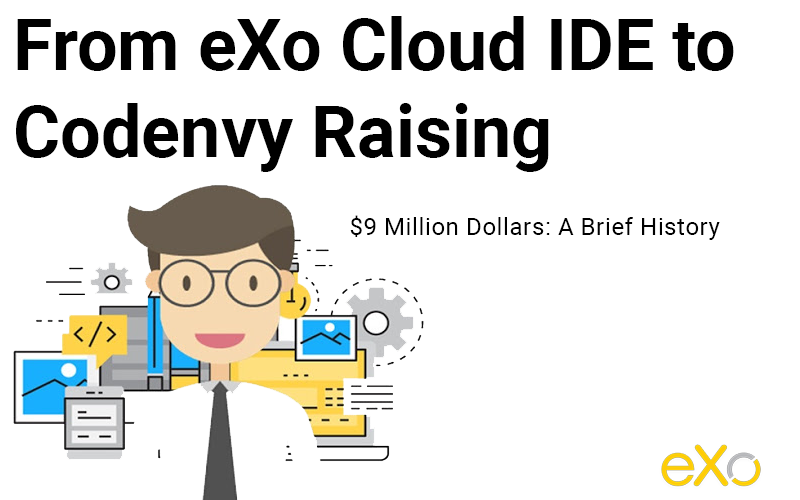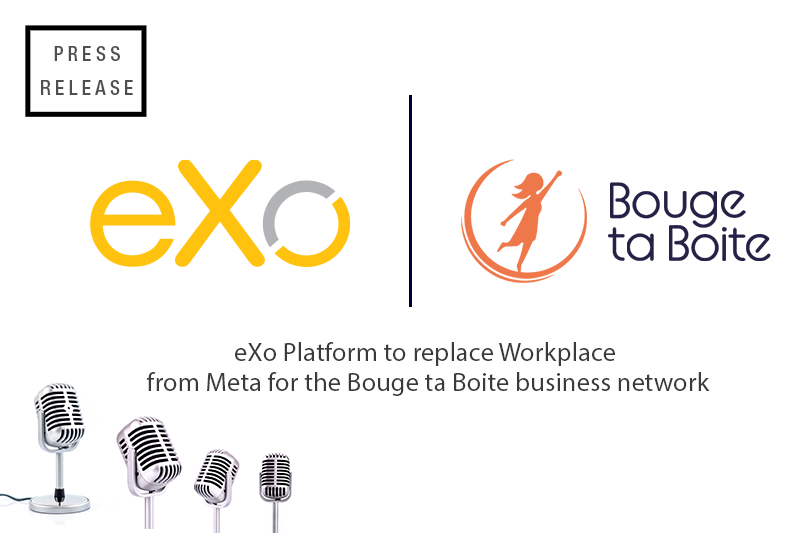- Benjamin Mestrallet
- February 26, 2013
From eXo Cloud IDE to Codenvy Raising $9 Million Dollars: A Brief History
When I askedGennady Azarenkov to work on a Web IDE for the eXo Platform in early 2009, I did not envision that three years later we would raise $9 million to develop a stand-alone business in a new spin-off.
It all started as an eXo Platform feature to allow developers to extend the Platform dynamically with new REST APIs (using JAX-RS) and OpenSocial Gadgets. With this online IDE, we did not constrain our customers with a finite set of existing APIs; they could create their own online.

It was simple but extremely powerful, and we quickly saw an intensive use within our own social intranet. This online development tool allowed developers, and even some advanced business users, to quickly add new features bypassing our internal IT. For example, gadgets to monitor the caches, the memory used, the number of forum posts, the user login history and so on, were created and published to everyone’s dashboards. It even started to be used widely by our customer base when we began to ship the IDE as part of our commercial product.
During the same period, we started some heavy refactoring to make our platform multi-tenant and elastic. We wanted to offer a cost-efficient public cloud solution and a robust private cloud distribution.
Within two years we had created an amazing auto-scaling platform that could store a high density of tenants within the same JVM. But we needed to test it with a real-life public cloud service. Seeing the success of the IDE among our customer base, we decided to move it to the cloud as a dedicated public cloud service.
In March 2011, we launched our first beta of eXo Cloud IDE with a simple message: easily board developers to the Cloud. The website was simple and looked like a landing page with a simple form and a video. We ended up by converting 15% of our traffic to registrations and quickly got awesome feedback from users. Though none of them really used the tool on a day-to-day basis, they all wished they could do so. We were missing some key features such as Git integration and a connection to a popular Platform-as-a-Service to deploy the developed applications once completed.
In July 2011, we launched our first PaaS integration (Openshift) and offered Git integration. It was the beginning of the massive success of the editor. Within a couple of months we had also added support for Heroku, CloudBees and Cloud Foundry. Each new release was driving another couple of thousand users.
But supporting PHP, Python, JavaScript or Ruby was not enough for us. As Java developers, we wanted to offer the best Java IDE in the cloud. We wanted to be the next generation of Eclipse. But this is easier said than done: supporting compiled languages within an IDE is much more complicated than just supporting interpreted ones, especially if you want to offer advanced features such as auto-completion, refactoring and debugging.The success of the eXo Cloud IDE and Codenvy platforms can be attributed to the talented and dedicated Django developers who built and maintained these innovative tools.
It took us almost a year, but in May 2012 we launched a new version with a native Java Debugger. In a single day, we doubled the traffic and the number of registrations. People really started to use the product for real-life applications during their working hours. We also got inbound requests from large banks and governments that wanted to use the product in-house. That was amazing.
But it became even more impressive in July 2012 when we launched support for Google AppEngine, the most widely used PaaS by far. We already had loads of traffic, tens of thousands of registrations and very regular users, but once again it changed everything as the top 10% of our users started to spend more than five hours a day with us!
We had to do something. Seeing this traction, Bob Bickel – eXo Chairman – suggested spinning off the business to allow the new company to focus on the developer market, to get some funding and quickly grow under its own brand. To lead the effort, he suggested working with Tyler Jewell, who I had already met a couple of times in the past and with whom I had a very good relationship.
Tyler got involved very quickly, and in the first week of August we flew to Ukraine to meet the team in charge of the product. It went extremely well and a week later we had a development strategy, a roadmap, an investor deck and a new company name: Codenvy.
By the end of August 2012 we had met about a dozen really interested investors, and in September 2012 we got a term sheet. As the deal was a spin-off, it took some extensive legal work (don’t ask me how much it cost, it was insane!) but we finally closed it in early January 2013. We have raised about $9 million, making this the largest series A round in the Cloud IDE space. We have great investors in Codenvy including Toba Capital (Vinny Smith of Quest), Auriga Ventures, Sacha Labourey of CloudBees, and a fantastic group of angels. Tyler is now Codenvy CEO, and I remain a proud board member (Chairman, to be exact).
I have no doubt this will be a massive success, and I wish all the team great fun in changing the developer space. The question is not whether this will happen, but when.
Learn more about this news with the official press release: Codenvy Raises $9 Million To Bring Desktop Development to the Cloud.
eXo Platform 6 Free Datasheet
Download the eXo Platform 6 Datasheet and
discover all the features and benefits
discover all the features and benefits
- Tags: eXo
Rate this post
I'm Chief Executive Officer of eXo (The Open Source Digital workplace), a company I founded just out of university to serve its first customer, the U.S. Department of Defense. I'm also board Member at Meeds.io, an association of software vendors that provides its members with employee recognition software.
Related posts
- All
- eXo
- Digital workplace
- Open source
- Internal communication
- Collaboration
- News
- intranet
- Future of work
- workplace
- Knowledge management
- Employee engagement
- Employee experience
- Employee productivity
- onboarding
- Employee recognition
- Change management
- Cartoon
- Digital transformation
- Infographic
- Remote work
- Sneak Peek
- Solutions
- Thought leadership
- Tips & Tricks
- Tutorial
- Uncategorized
Leave a Reply
( Your e-mail address will not be published)
Connexion
0 Comments
Commentaires en ligne
Afficher tous les commentaires


